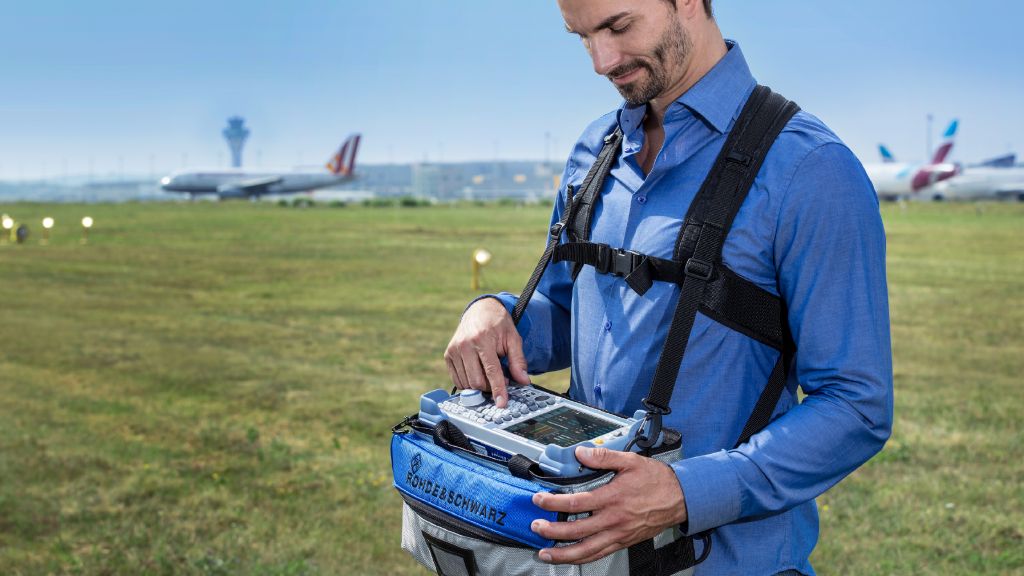Verify your GBAS signals with high reliability
The R&S®EVSG1000 and R&S®EVSF1000 are signal level and modulation analyzers that reliably analyze GBAS systems during ground and flight inspection when used together with the R&S®EVSG-K4 option.

The R&S®EVSG1000 and R&S®EVSF1000 are signal level and modulation analyzers that reliably analyze GBAS systems during ground and flight inspection when used together with the R&S®EVSG-K4 option.


A ground based augmentation system (GBAS) delivers differential GNSS correction data in real time to enable precision approach and landing for aircraft. The GBAS ground station (control center) uses data from two to four GNSS reference receivers located around the airport to create a correction message. The correction data is transmitted via a VHF data broadcast (VDB, 108.025 MHz to 117.95 MHz) to the receiver of the approaching airplane to correct its received GNSS signal. The D8PSK modulated VDB data is sent in bursts with eight timeslots each. Each slot carries application data which can belong to one or more message types (MT).
GBAS must fulfill the most stringent safety requirements. To ensure precise operation and worldwide compatibility, the International Civil Aviation Organization (ICAO) standardized critical GBAS parameters. Service providers and flight inspection organizations regularly monitor, check, calibrate and certify GBAS navigation systems to ensure conformance with the specification – essential for ensuring public safety. These activities call for robust and reliable test equipment that meets all relevant requirements, from calibration to installation and maintenance in the lab and in the field.


The R&S®EVSG1000 and R&S®EVSF1000 are designed especially for commissioning and servicing ILS, GBAS, VOR and marker beacon ground stations and for analyzing air traffic control communications (ATC COM) signals. The R&S®EVSG1000 is a portable, battery-powered device designed for ground inspection and installation in measurement vehicles. The mechanical and electrical design and the high sensitivity of the R&S®EVSF1000 make it ideal for state-of-the-art flight inspection.
The R&S®EVSG-K4 option adds GBAS test functionality to both devices to reliably verify and analyze the VHF data link (VDL) via which GBAS stations in the field broadcast differential correction messages. The frames of a GBAS message burst are easily synchronized by connecting the PPS output of an external GNSS device to the PPS/trigger input of the R&S®EVSG1000/R&S®EVSF1000. The analyzers capture the eight GBAS timeslots and decode their content.


Time domain analysis of a GBAS frame
For each timeslot (A to H), the instruments analyze all important GBAS parameters. Different views allow:
The R&S®EVS-K9 option displays the decoded timeslots of a GBAS signal in various views. The GBAS main view provides an overview of the eight timeslots of a VDB message, listing the most important parameters such as level and frequency offset for each slot. This enables operators and technicians to verify GBAS functionality at a glance.
To ensure stable conditions for further analysis, the sequence of messages can be paused and single frames or bursts can be selected. The analysis can then be done offline without interrupting e.g. an ongoing data recording or streaming in the background. To be prepared for eventual changes to message type specifications in the future, all MTs are defined by XML description files. Standard XML files for MT1 (contains GPS correction data: satellite information and pseudorange corrections), MT2, MT4 (contains the final approach segment data block (FASDB)) and MT11 are included in the scope of delivery. The user can modify files for existing MTs or create new MT description files if required. All measured values and data content can be streamed, recorded, saved and exported via USB flash drive using the instrument’s data recorder.
The R&S®EVSG-K5 option provides similar functionality for SCAT-1 signals based on the RTCA DO-217 standards.
Equipped with GBAS functionality, the R&S®EVSG1000 is an ideal choice for analyzing GBAS systems. The same measurements can be made via flight or drone inspection with the R&S®EVSF1000. Both instruments support all NavAid systems in line with the relevant standards, making them the perfect tools for ATC organizations, flight inspectors and service technicians.